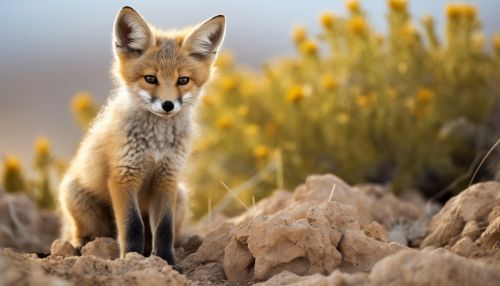Kit Fox
Taxonomy and Evolution
The Kit Fox (Vulpes macrotis) is a fox species of North American desert environments. It is a member of the Canidae family, which includes other foxes, wolves, and domestic dogs. The Kit Fox is a part of the Vulpes genus, which includes twelve other species of foxes.


The Kit Fox's closest relative is the swift fox (Vulpes velox), and these two species are sometimes considered conspecific, meaning they belong to the same species. However, recent genetic studies have suggested that they are, in fact, separate species.
Description
The Kit Fox is the smallest wild canid found in North America. Adults typically weigh between 1.6 and 2.7 kilograms and measure 455 to 535 millimeters in body length. The tail adds an additional 250 to 340 millimeters to their length.
The Kit Fox has a slender body with long, thin legs, which are adaptations for its desert environment. Its large ears, another desert adaptation, help dissipate heat and detect prey. The fur of the Kit Fox is usually a grizzled gray color on the upper body, with a lighter, almost white color on the underside.
Distribution and Habitat
The Kit Fox is found in arid and semi-arid regions of the western United States, primarily in the Great Basin, the Sonoran, and the Mojave deserts. It has also been found in the arid regions of Mexico.
The Kit Fox is highly adapted to desert life. It prefers habitats with loose soil suitable for digging dens, and its small size allows it to navigate through dense vegetation and rocky terrain.
Diet and Hunting
The Kit Fox is an opportunistic predator and omnivore. Its diet primarily consists of small mammals, such as kangaroo rats, jackrabbits, and cottontails. It also eats birds, reptiles, and insects.
The Kit Fox is a nocturnal hunter, using its keen hearing and sharp vision to locate prey. It uses a pouncing technique to capture small prey and can chase down larger prey over short distances.
Reproduction and Lifecycle
Kit Foxes are monogamous, and mating pairs maintain territories that they defend from other foxes. Breeding season occurs from December to February, and after a gestation period of approximately 50 days, females give birth to a litter of 3 to 6 pups.
The pups are born in dens, which provide protection from predators and extreme weather. Both parents participate in rearing the young, with the male providing food for the female and the pups.
Conservation Status
The Kit Fox is listed as a species of least concern by the IUCN. However, it faces threats from habitat loss due to urban development and agriculture, as well as competition with the larger and more aggressive red fox.
